By now, the world is aware of Croatia and their ability to surprise; the 2018 World Cup finalists and 2022 bronze medal winners are no longer just the dark horses of every international tournament they participate in; they are genuine challengers for the title.
However, the European Championship has been a completely different experience for Vatreni.
Historically, this has been the competition and struggle the most, and looking at the tough group stages that await them with Spain, Italy, and the unknown, Albania and Croatia might face another uphill battle on the international stage.
That said, though, they’ve earned the right not to be doubted anymore.
But how far can they go? What are their tactics? And what should we expect from Zlatko Dalić this time around?
In this tactical analysis, we’ll go over their squad, key players, and tactics and give you a final prediction heading into Euro 2024 in Germany.
Our analysis and scout report will also give you a statistical overview of the team and their exploits thus far.
Predicted Starting XI
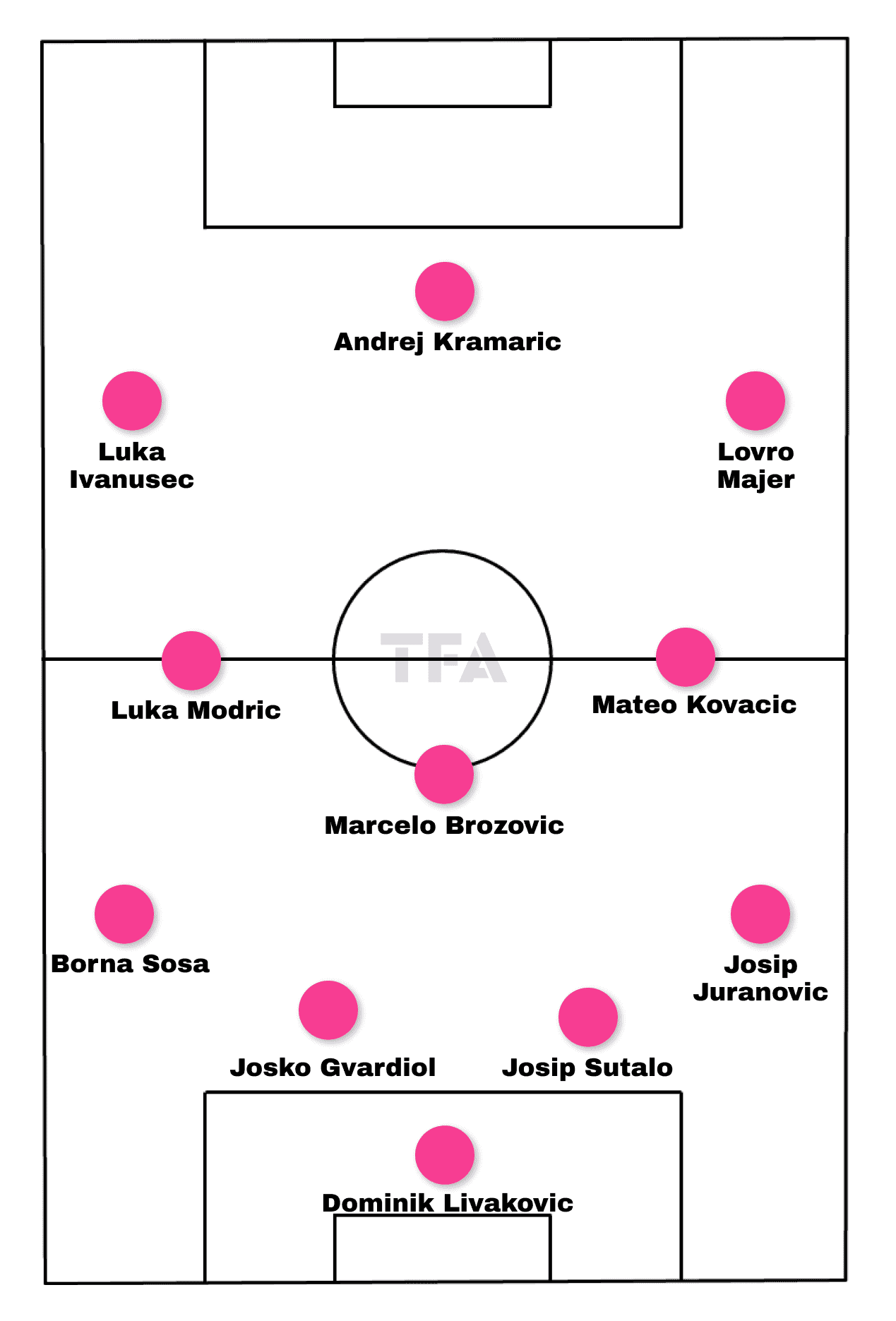
Croatia has a strong core with an influx of young and exciting talent from all across Europe.
Even though it is a small country compared to some other giants of elite football, its players feature for some of the best teams on the planet.
Dalić, as a coach, doesn’t want to tinker too much with what seems to work and will reward loyalty and overall influence on the team.
This means that some of the long-standing veterans are likely to retain their spots, and once Dalić is happy with the equation, that is unlikely to change as long as it keeps giving results.
For that reason, Croatia are expected to be deployed in a 4-3-3 structure, with Dominik Livaković manning the sticks behind a four-man backline.
There is some scope for rotation in that defensive line, but on paper, Borna Sosa, Joško Gvardiol, Josip Šutalo and Josip Juranović are the likely candidates.
Of course, there is a chance Dalić decides to put his Manchester City weapon, Gvardiol, on the left and then give Martin Erlić a chance at left centre-back.
On the right, while Juranović remains the top choice, we may also see Josip Stanišić there.
The midfield is self-explanatory since that’s still the heartbeat of this Croatian team.
Marcelo Brozović is the pivot, flanked by Real Madrid’s Luka Modrić and Manchester City’s Mateo Kovačić.
The only real rotation that we might actually see is Lovro Majer for Kovačić, but considering Majer can and does also play the right wing, chances are we’ll still see the trident of Brozović, Modrić, and Kovačić.
In the frontline, the situation is somewhat less clear.
Luka Ivanušec could start on the left side, seeing how Ivan Perišić is already 35 and struggling at times, but again, seeing how Dalić values that experience and loyalty, the current Hajduk Split veteran is not completely ruled out.
Down the middle, we could either see Andrej Kramarić or Bruno Petković and, in some situations, even Ante Budimir, but less likely.
On the right, it could be Majer unless he starts in midfield, but it could also be Kramarić if he’s not the centre-forward.
There is scope for more rotation there, but as Dalić isn’t one to reshuffle the deck constantly, especially for big occasions, a somewhat standardised XI is to be expected.
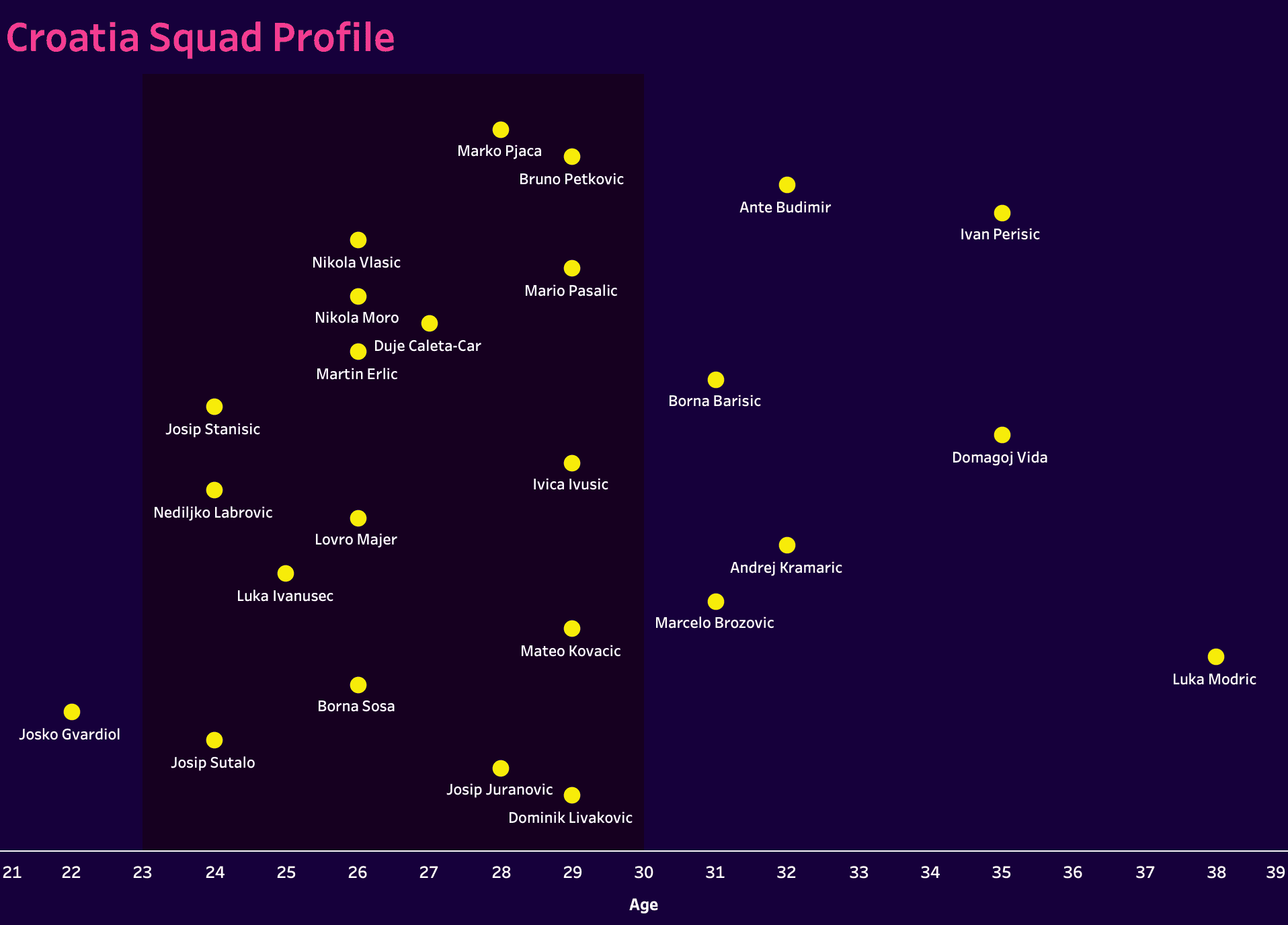
Looking at the squad depth chart and the age profile of this Croatia team, we can see that they have a nice mix of a veteran core and exciting youth.
The majority of the players, however, are still in their prime years, which bodes well for the maturity and overall ability of the squad.
We do have to mention that quite a few veterans are leading the way even deep into their experienced years, but that is part of Dalić’s philosophy, too; players like Modrić, Domagoj Vida and Perišić might not be available to play every game from start to finish (apart from Modrić) but are there for both sporting and moral impact.
Modrić, in particular, acts as a secondary coach for Croatia as he’s often the mentor on and off the pitch.
Interestingly, all three main areas of the squad are quite well balanced, so the experienced players are sprinkled throughout the team, offering their unique input and value while also being backed up by individuals in their prime years.
All of that makes for a team with enough depth and quality to challenge anyone.
Attacking Phase
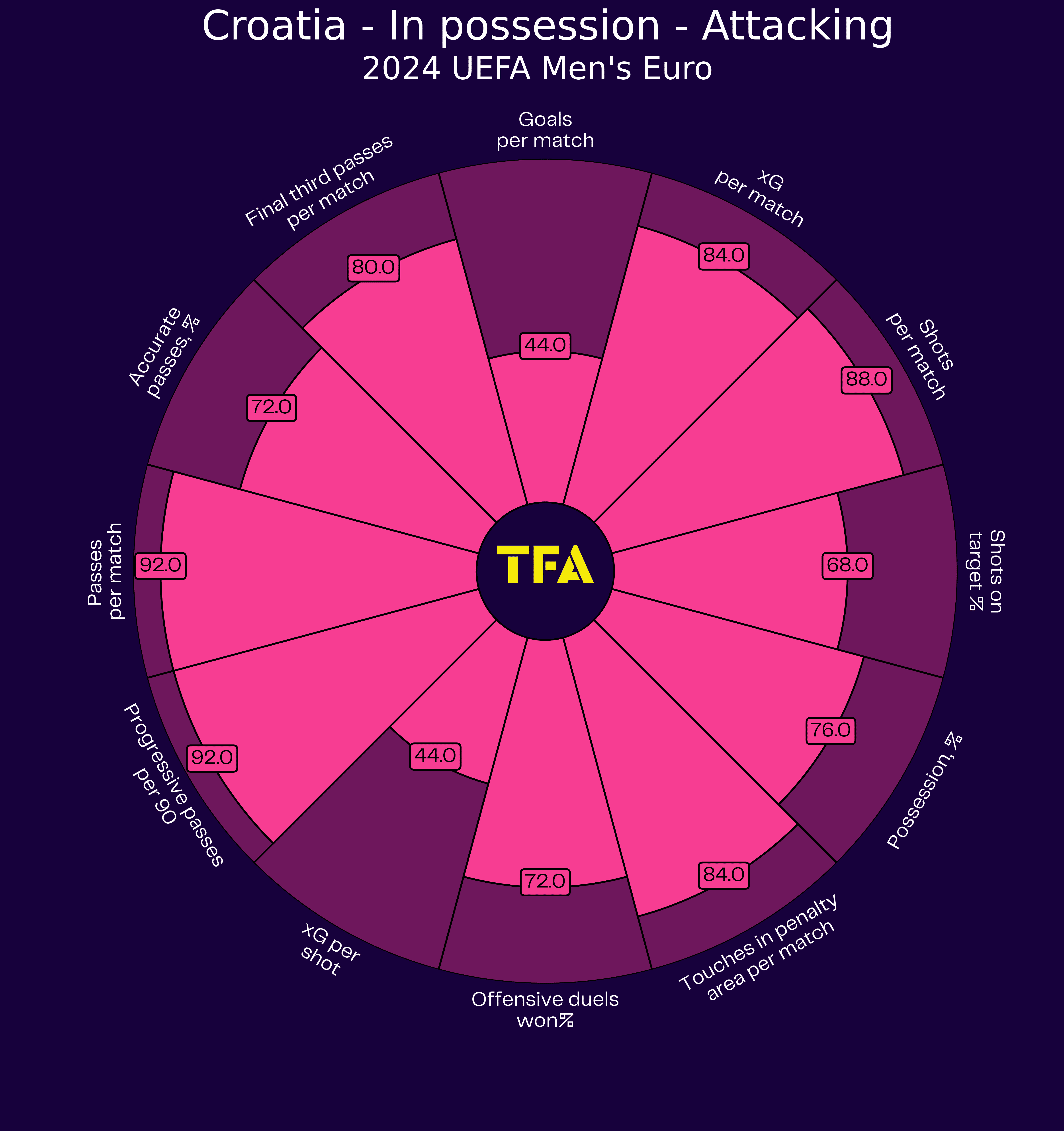
Looking at the attacking graph for Croatia’s last calendar year, we can see that they are a dominant force in possession of the ball.
Dalić likes to control games and does so extremely well with that sublime midfield trident of Brozović, Modrić and Kovačić.
Of course, one of the criticisms the head coach is still receiving to this day is the lack of a tactical nous when it comes to structuring and instructing the team how to outwit the opponent.
Dalić is a master man-manager, something akin to Carlo Ancelotti of Real Madrid, but doesn’t necessarily outplay other coaches like Pep Guardiola, Thomas Tuchel or even Arsenal’s Mikel Arteta.
Instead, he is there to put them in the right places and allow them the freedom to do what they do best.
Essentially, he is all about optimising the squad and creating the best possible environment for them to thrive.
Still, that doesn’t mean Croatia don’t have a clear approach to games.
The data analysis suggests they generally like to dominate the ball and deploy a lot of passes, building up towards the final third.
Naturally, this is helped by the technical quality of their midfield and backline.
Generally, all three midfielders will be heavily involved in the first phase of play and will even drop just ahead or even into the backline to help ease progression against the opposition’s pressure.
Modrić, in particular, is very good at recognising when to drop and how to find the right passes, breaking the lines in the process.
But the other two can do it as well, which is a part of this midfield’s brilliance.
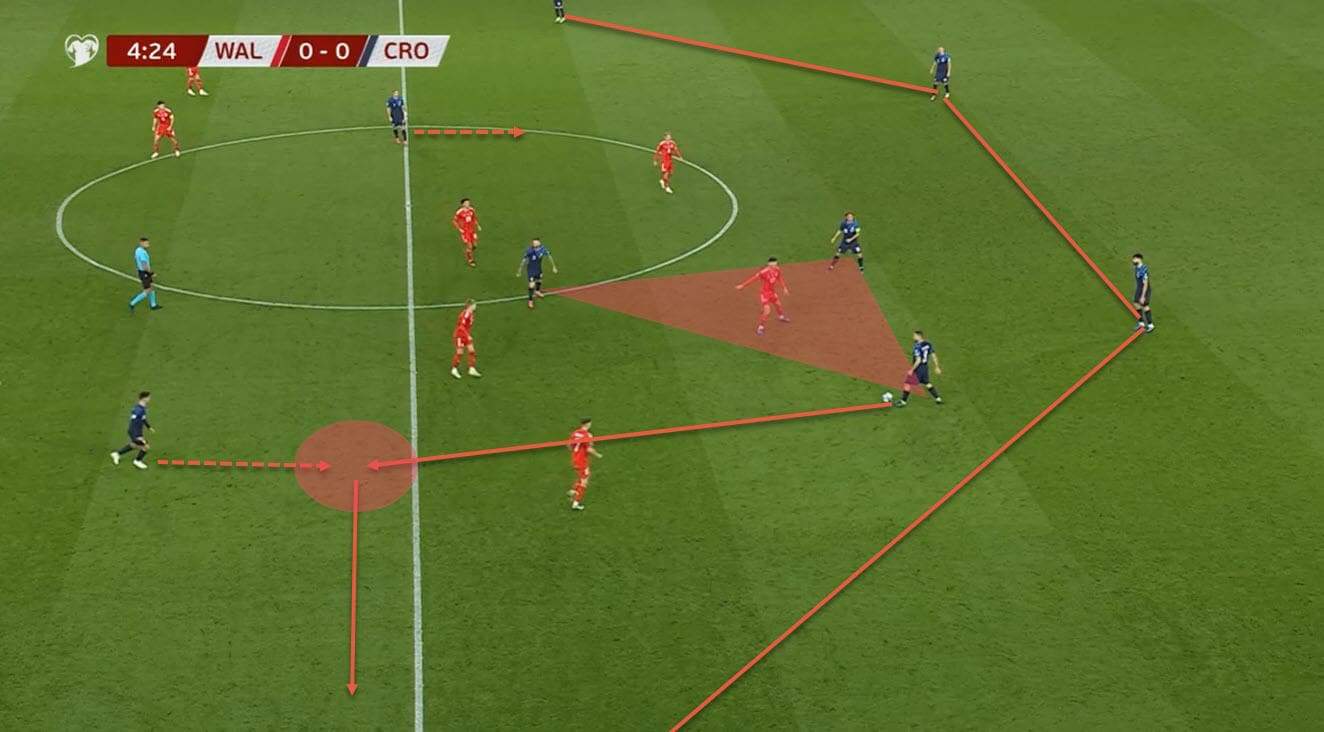
Interestingly enough, for a team that likes to be dominant in possession and a team of midfield giants, they struggle to access the central corridors or choose not to.
Even when the likes of Modrić or Kovačić get on the ball with space and time, and even if the first line of the opposition’s defensive structure is broken, Croatia tend to recycle the ball towards the flanks reasonably early in the build-up phase.
This can be done via a simple long pass into the isolated targets, through one-twos between the midfielders, or by using more intricate third-man sequences to access the less congested areas of the pitch.
If we look at the touch and pass maps, respectively, we will see that the data confirms this thesis and shows a clear preference for the wide areas.
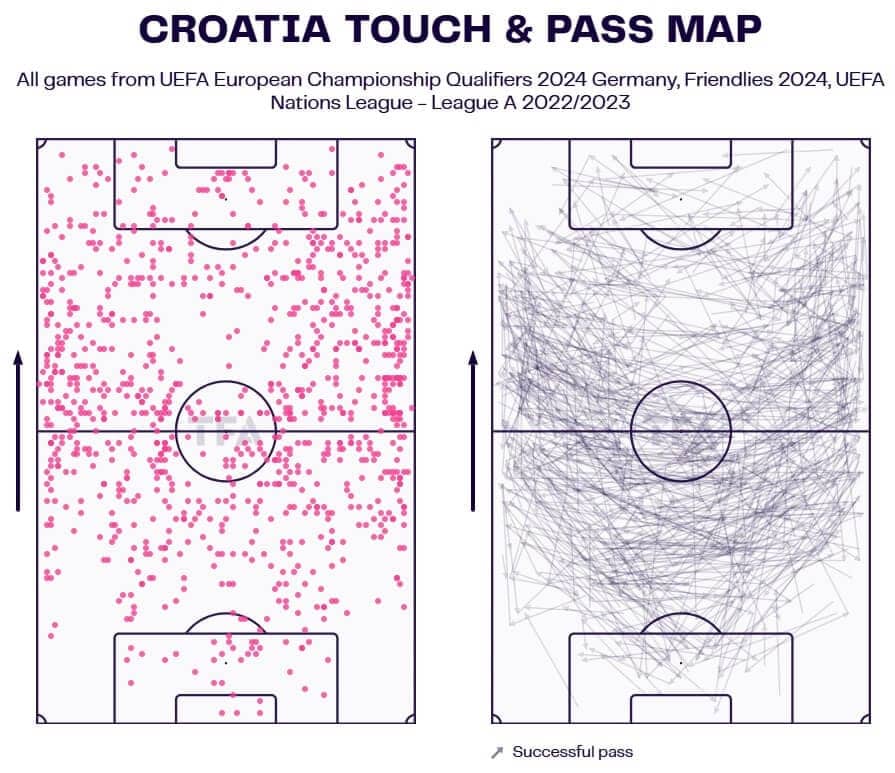
This, of course, is more visible in the final third of the pitch and most likely comes as a direct consequence of having all three midfielders very deep in the first phase.
Notice the gaping hole down the middle and just ahead of the opposition’s penalty area.
Even though this is one of the most valuable zones to access, Croatia seem to struggle to get there or to occupy those zones efficiently.
Still, this insistence on the wide areas seems to be by design and not by necessity; Croatia have dribblers and distributors out wide so getting the ball into those areas when setting up the attack does make sense.
When we look at their progression maps next, we can see that most of their carries, dribbles and even passes into the box originate on the flanks.
On the other hand, the passes from the central areas are mostly directed towards the wings as the step before the final entry.
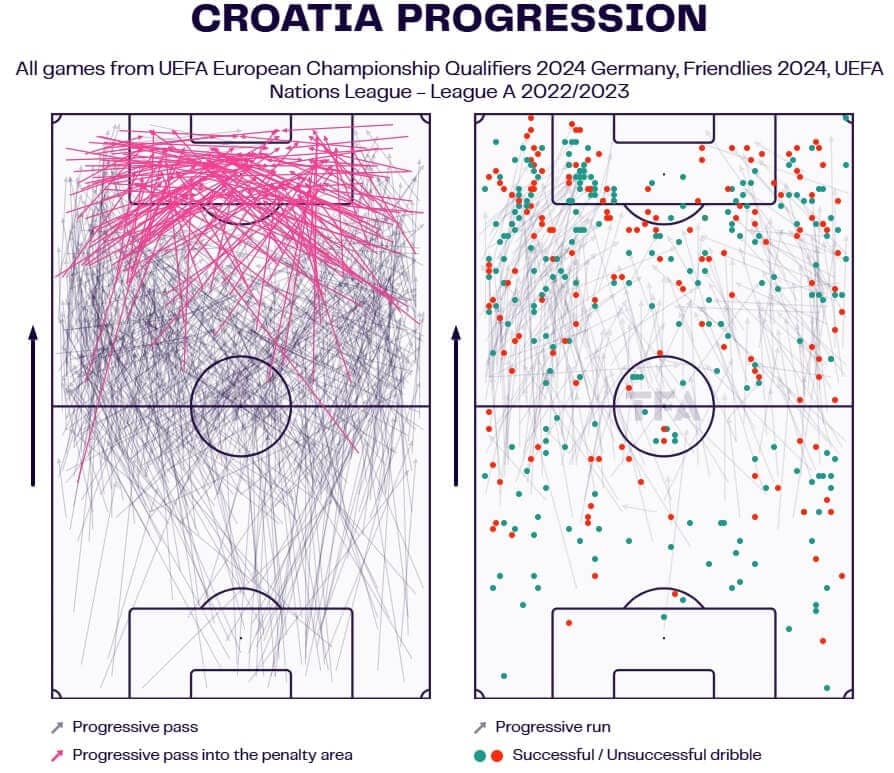
But the graph on the right is quite interesting because it also shows us how courageous Croatia are in the first phase of attack and how they still favour the left side when progressing up the pitch.
The sheer number of dribbles and successful dribbles tells us they tend to beat pressure often by carrying the ball upfield.
Certainly, having three press-resistant technical monsters in that midfield line and great ball-playing centre-backs helps in that regard as well.
All of that said, however, it’s the second phase that sets up the wide approach the most.
It’s there that Croatia tend to be extremely narrow in possession, and that’s how they force the opposition to abandon the flanks and focus on defending the central areas instead.
As a result, the wings get freed up, and it’s much easier to create isolations for their creators and distributors to drift there from deep or central areas.
The wingers will crash into the box while the full-backs or even midfielders rotate out wide and then send passes for the runners.
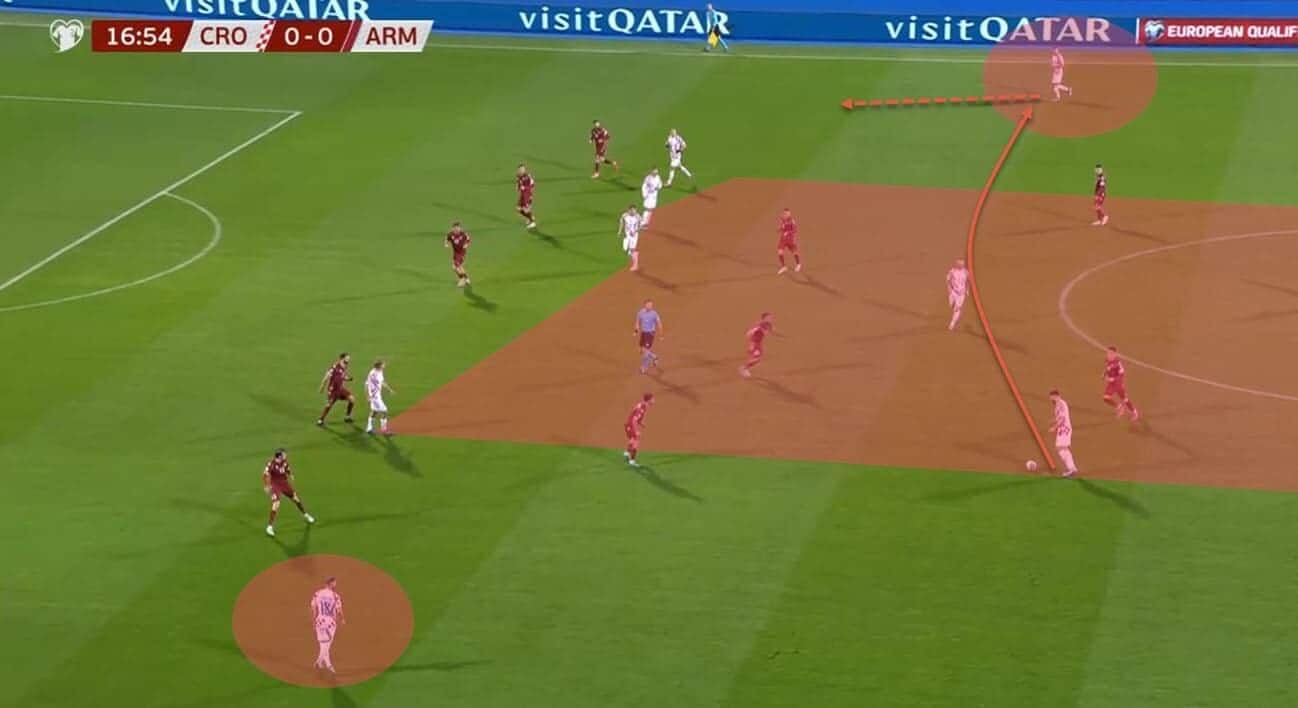
We can see an example of this extremely narrow shape in the latest sequence; Croatia overload the central areas so that the opposition is forced to react.
Once everyone has moved away from the wings, it becomes much easier to progress through those channels and then distribute the ball into the box.
The data confirms this is where most of the early phase passes end up, so we can conclude this is indeed something Dalić does by design and something that is part of their tactics.
Judging by both the numbers they output and the results so far, the approach seems to be working.
However, Croatia still struggle in front of goal.
Looking at their final product in the last calendar year at the moment of writing this tactical analysis, it seems that despite registering high percentile rankings in shot volume, expected goals per match and touches in the opposition’s penalty area, they still rank below average in goals per game.
In short, all of their attacking metrics on the international stage rank them among the best or near the best, ranging from around the 70th percentile to the high 80s, but finishing and lethality are still subpar on occasion.
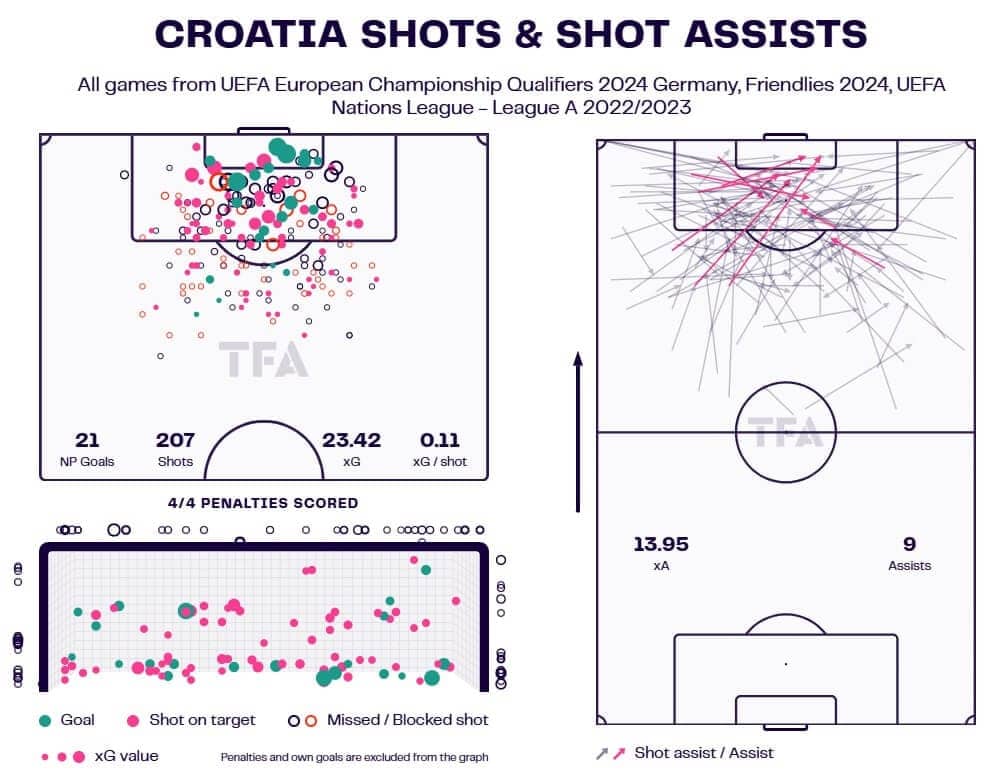
If we once again look at the data analysis itself, we can see that they are currently underperforming their expected goals, albeit not by match, since we’ve included the Nations League performances this time around, which improved their overall numbers.
Still, 0.11 xG per shot is not a bad figure, but when we add to that the underperformance in expected assists as well, we start to see these cracks in attack appear once more.
Whether or not it comes back to bite them at the Euros remains to be seen.
Defensive Phase
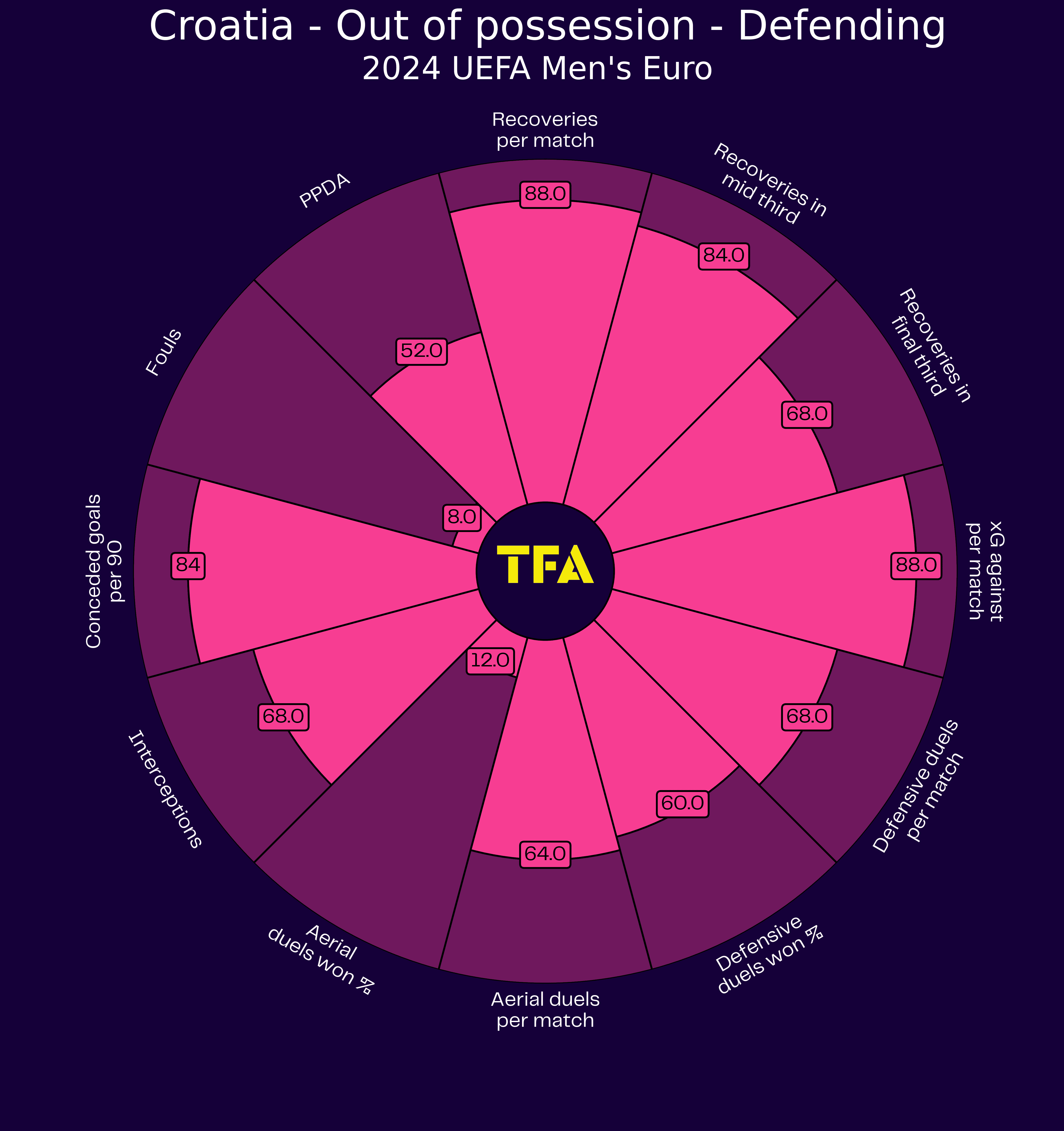
Again, we start this section of our tactical analysis with a data overview of Croatia’s defensive phase of play.
According to our numbers, Dalić’s squad enjoys most of its success out of possession in a mid-to-high block, with the most intensity being shown in the middle of the pitch.
Croatia are average to just about above average duellers; they rank around the 60th percentile in most duels on the ground but are quite shaky in the air, and this does pose a certain problem for Vatreni.
Once again, when it comes to applying pressure, Croatia is not among the most aggressive teams but will push up on occasion, especially in the opening stages of the game with fresh legs.
However, that isn’t something that’s often sustainable or preferred, and Croatia will step down into a flatter 4-4-2 once the dust finally settles.
In that scheme, they are largely man-oriented and will aim to keep the midfield track man-for-man while the front two players follow the ball and disrupt the backline.
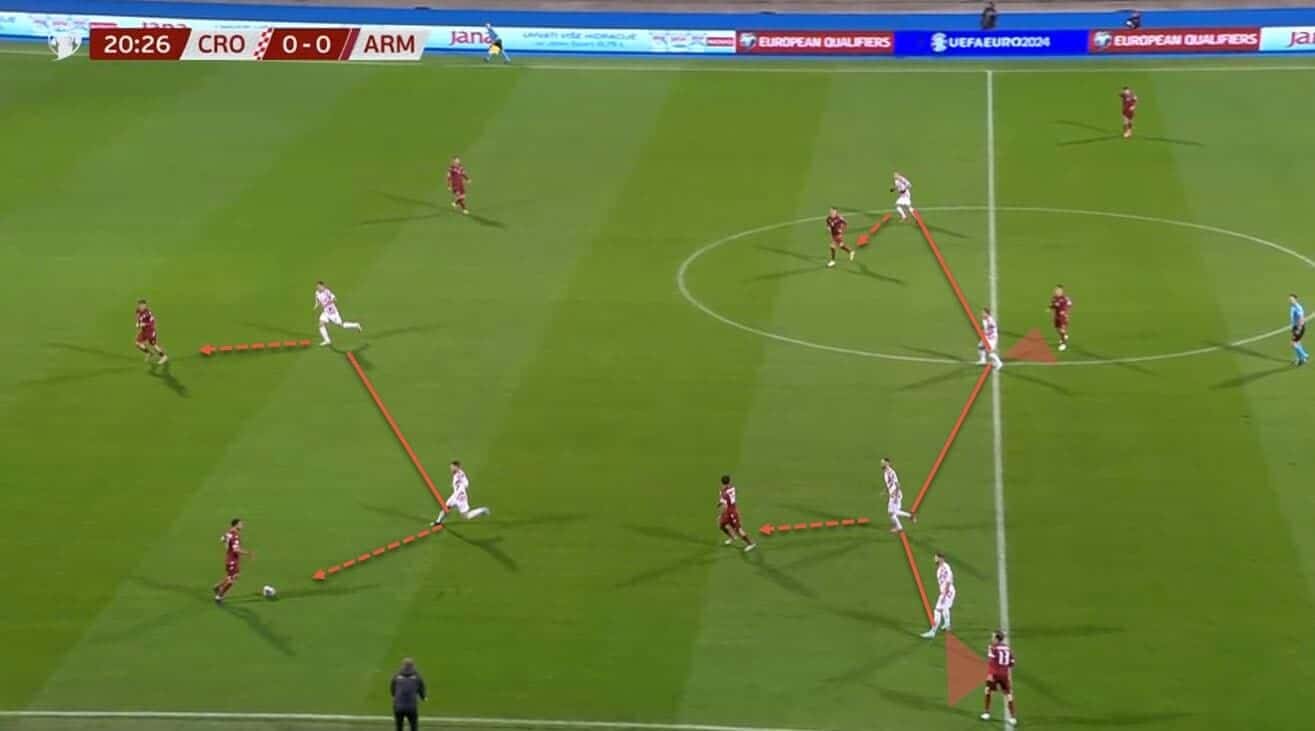
If we refer back to the first graph of this section of our tactical analysis, we can conclude that the Croatian mid-block is still quite effective, as Dalić’s troops rank in the 84th percentile for conceded goals.
And considering the metrics for the against categories are reversed, the higher the percentile, the better the indicator.
Still, we can’t say they are flawless in their execution, either.
We must note that once they are committed to a high press or even counter-pressing in the middle third, which is one of their chance creation tools, they will aggressively push up their defenders.
Once that happens, the centre-backs will often follow their markers deep into the middle third, abandoning their positions and leaving space behind their backs.
Generally, when teams look to hurt Croatia through distribution and exploiting the space, they would be looking for isolations created after pulling the centre-backs deep, as seen in this example against Wales.
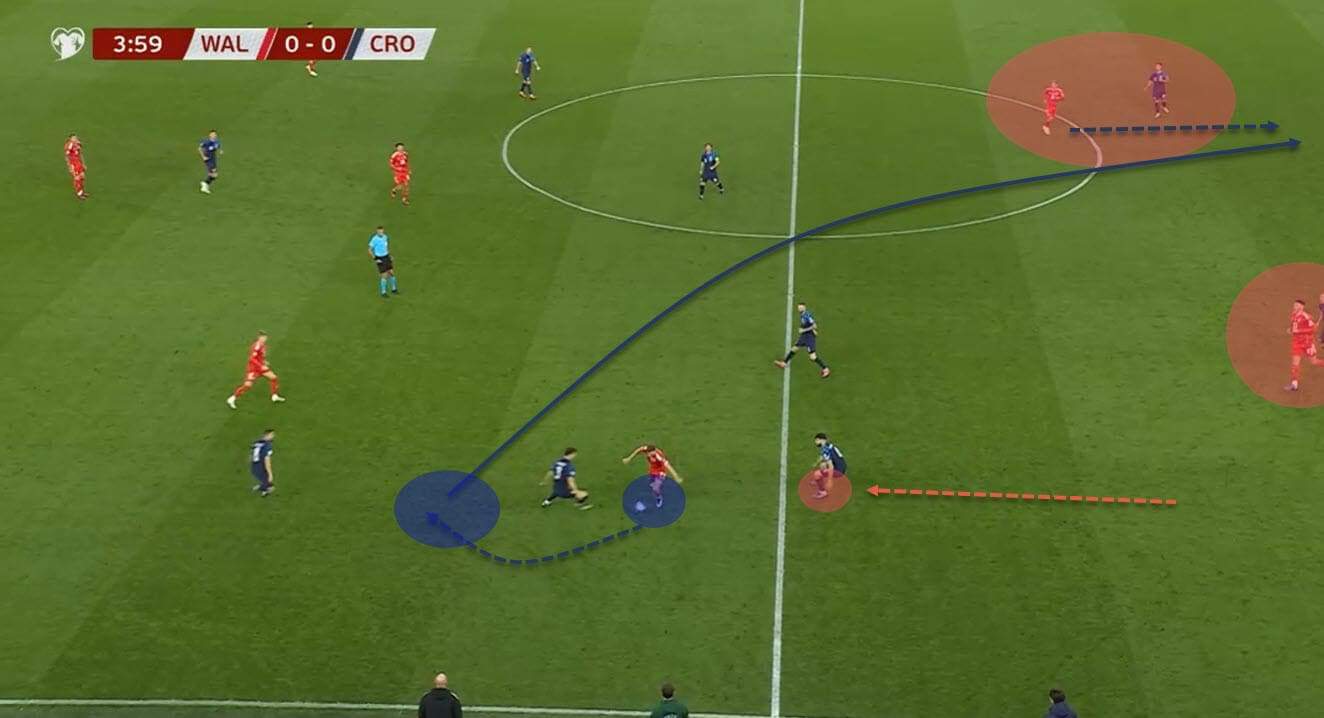
However, even if their execution is not flawless, the Croatian defence still holds strong.
Part of that is also due to stable possession, as these two are inevitably intertwined; how you attack informs how you defend and vice versa.
However, individual performances also drive a lot of their defensive showing; the collective is strong, but the singular cogs in the machine can perform on a high level as well.
If we look at the prevented expected goals through goalkeeper stops and blocked shots by the outfield players, we see that Croatia has an overall net positive.
The efforts are more or less the same from the right and left side of the pitch, and generally, the number of high expected goal shots is not alarming as of right now.
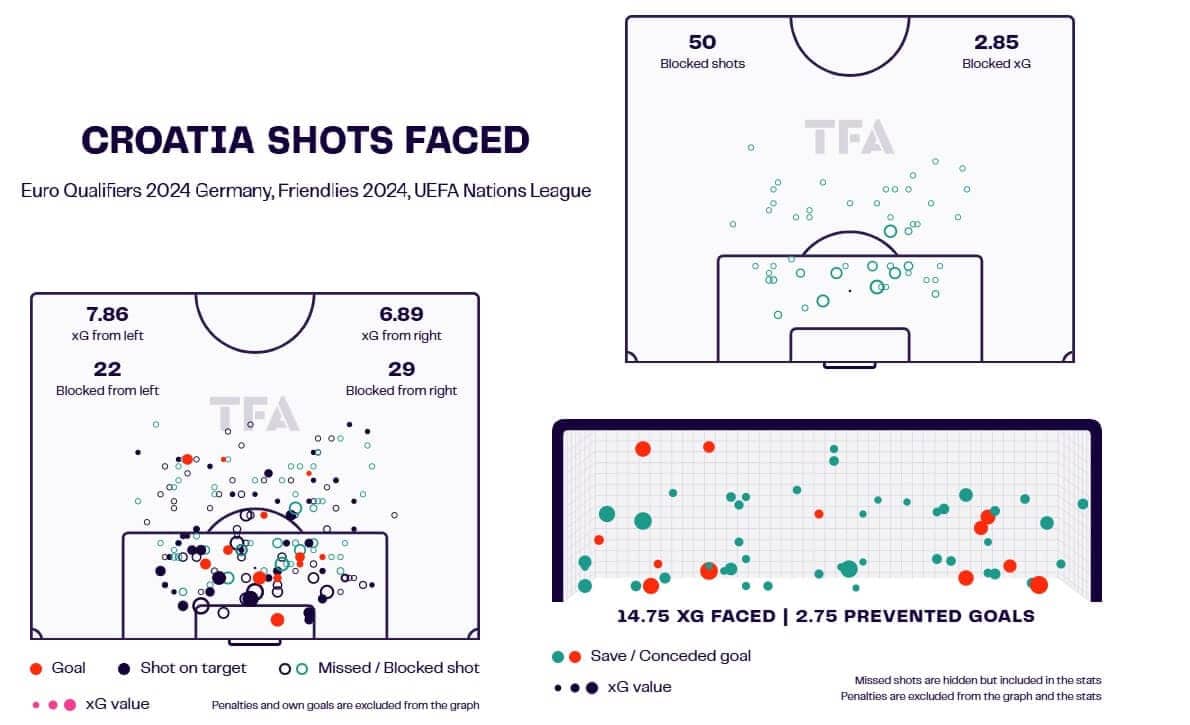
Croatia’s power mostly comes from their in-possession quality, but it seems the defensive phase is not lagging too far behind.
It’s far from flawless, but it still gets the job done.
Transitions
Transitions are a part of Croatia’s attacking firepower but can sometimes be suboptimised due to the lack of bodies on the counter-attack.
Generally, however, they have a nice balance of runners up front and distributors in the back, which is how they will largely structure these transitional attacks.
The midfielders and the ball-winners are deeper, while the legs are in the frontline and the wide areas.
With such a structure, they aim to maximise the output while also minimising the flaws since they don’t force the likes of Modrić to waste their stamina going up and down the pitch.
Of course, Modrić being Modrić, he will still do a lot of legwork for this Croatia team, but it wouldn’t be his primary task to attack teams in transitions and eat a lot of ground.
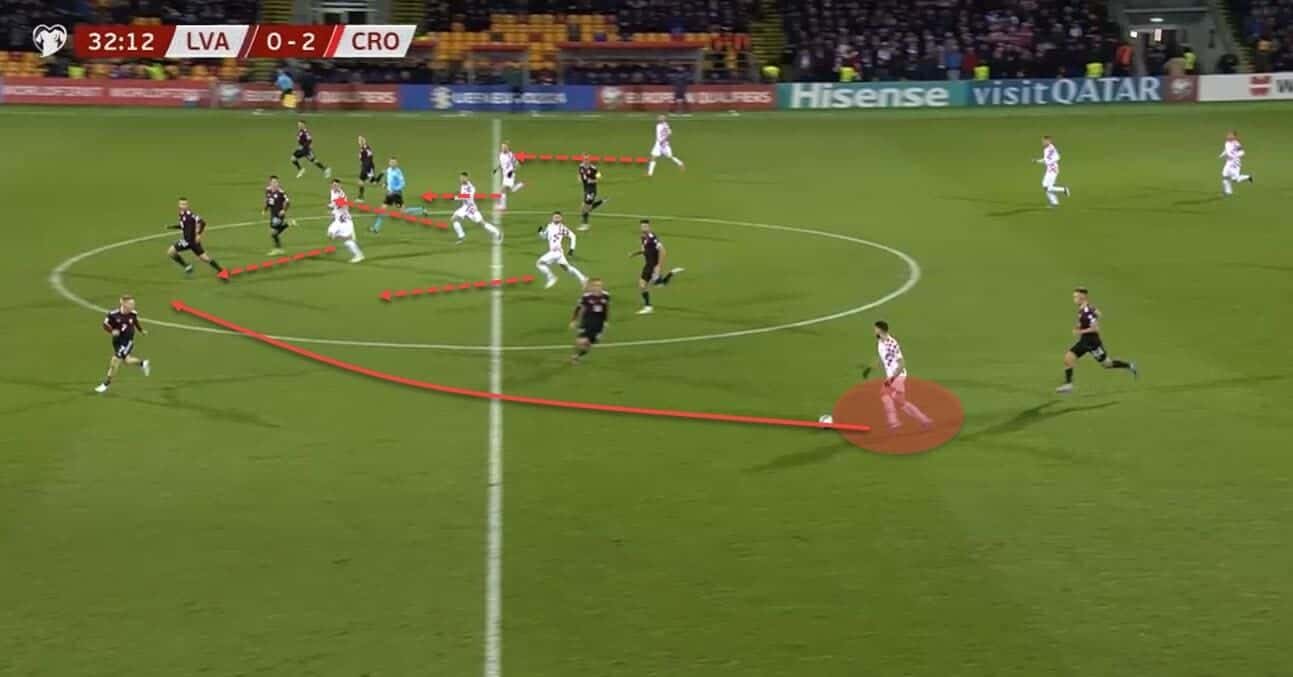
Here is a sequence depicting one such action where Croatia managed to get enough bodies forward and give their distributor from the deep enough targets to aim for.
One thing to note here is that the centre-backs, especially if they are Gvardiol and Šutalo, will take a lot of responsibility in possession, including the transitions, so seeing them run with the ball after a prevented attack is not out of the ordinary.
But Croatia, as a team that pushes people forward and even asserts dominance aggressively, can be susceptible to counterattacks.
In the previous section of our tactical analysis, we talked about teams creating isolation in Vatreni’s backline, and the same can sometimes be used in transitional moments.
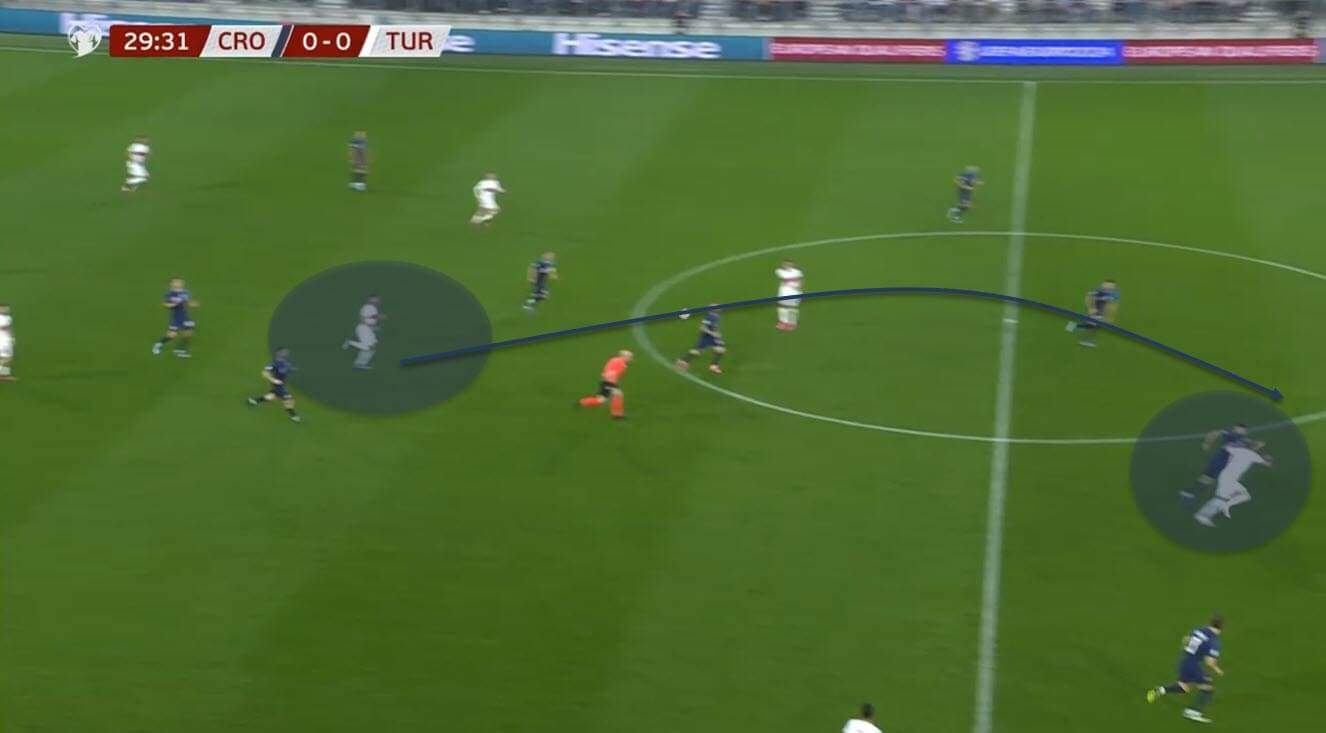
The issues arise when there isn’t enough intensity or compactness in the middle third, where Croatia win most of their duels.
If the opposition is granted enough time and space on the ball and Croatia still pushes up instead of backing down in time, these isolations, like the one against Turkey in the latest sequence, can be deadly.
Forwards
Even though Croatia is a formidable force going forward, finishing remains one of their current biggest struggles.
The personnel seem good enough for the job, though; Petković, Kramarić, and even Budimir, should he feature, are all good goal-scorers in their own right, and all are geared towards a different approach.
The only real out-and-out number 9 is Budimir, while the other two can be hybrids and more combinatory options.
Still, with one of them leading the line and a potential winger pairing of Ivanušec (or Perišić) and potentially someone like Majer on the other end, there is a good blend of profiles, ability and outlets to be effective in almost any game state Croatia might face this Euros.
Majer, in particular, has been stellar in the qualification run, and while he may not always be the first name on the standardised team sheet, there is an argument to be made that he’s been Croatia’s biggest threat lately.
Whether or not that’s enough for Dalić to slot him in instead of someone like Kramarić (who can often play at RW, too) remains to be seen.
Midfielders
The midfield is still Croatia’s bread and butter, and that hasn’t changed.
Of course, a big part of that prowess is thanks to none other than the 38-year-old midfield maestro Modrić.
But alongside him are equally important Brozović and the ever-present Kovačić.
Together, they make for probably the most important cogs in the Croatian machine, which is the reason why this team can tango with the best of them.
While it’s difficult to displace any of them, there is a possibility we will see someone like Majer in the midfield line instead of the right-wing, and that will add a different flavour to the whole recipe.
However, when it comes to the big games and the most important occasions, it’s difficult to see Dalić step away from what still works.
He does, of course, have the likes of Nikola Moro and Mario Pašalić on the sidelines in case of an emergency, but as far as the starting trident is concerned, those spots are long taken.
Defenders
Croatia’s defence has a good mixture of experience, especially on the big stage, and some of the best young players in the squad and even beyond.
Gvardiol, of course, is an example of both of those aspects merged into one, but his centre-back partner and the full-backs have big roles to play in the team.
Interestingly, we have seen quite a bit of rotation in the backline as of late, so it’s difficult to guess which way Dalić will go, but whether it’s at left-back or centre-back, we know Gvardiol will be leading the defence line.
As far as the goalkeeper is concerned, Livaković seems nailed on for the position, and that is unlikely to change.
But that’s not necessarily a bad thing either; Croatia has often relied on his heroics, and he is the type of player who can live up to expectations and deliver in the heat of the moment.
Of course, Dalić may also call up the likes of Nediljko Labrović and Ivica Ivušić, once again giving him a mixture of youth and experience, and they would be good back-ups but are unlikely to displace the number one choice.
Key Player
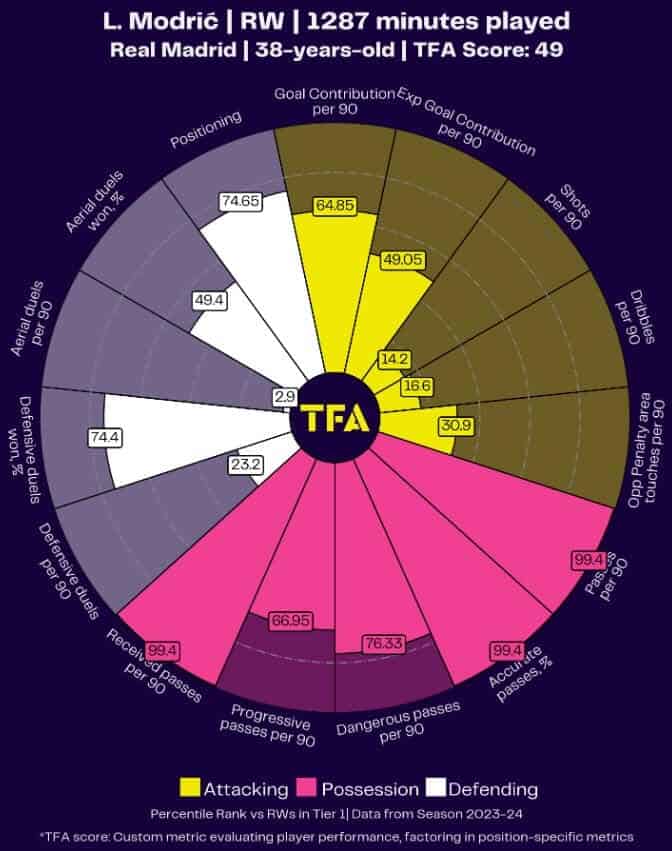
Was there ever any doubt? Even at the age of 38, Modrić remains the most influential figure of this Croatia squad, both on and off the pitch.
On the pitch, he’s the metronome around whom everything revolves, and off of it, he’s the leader and mentor to both young and old.
In a way, Modrić truly is timeless and transcends the mortal rules of football, but at the same time, Croatia is also aware that the Swan Song is just around the corner.
Interestingly, however, the key player honour could’ve gone to the likes of Gvardiol or, in a much less obvious manner, to Majer as well.
Both of these players can dominate the opposition and flip a switch to turn the tides back in Croatia’s favour.
But no one in this squad is as effective and as influential as Modrić himself.
Tournament Prediction
Euros are a mixed bag for Croatia.
While on the World Cup stage, they always seem to overperform all and any expectations.
The European Championship is the complete opposite, and often, even if they are highly regarded heading into the competition, they sadly often underperform.
But in a vacuum, this squad has enough firepower to make a deep run and break the curse of the Euros that’s been following them for multiple championships already.
Dalić is a coach who’s good at maximising the players he has, and if they go to Germany feeling good and comfortable, we may see them reach at least the quarter-finals.
In any case, that’s what they are capable of, and that’s what we think they will accomplish this year.

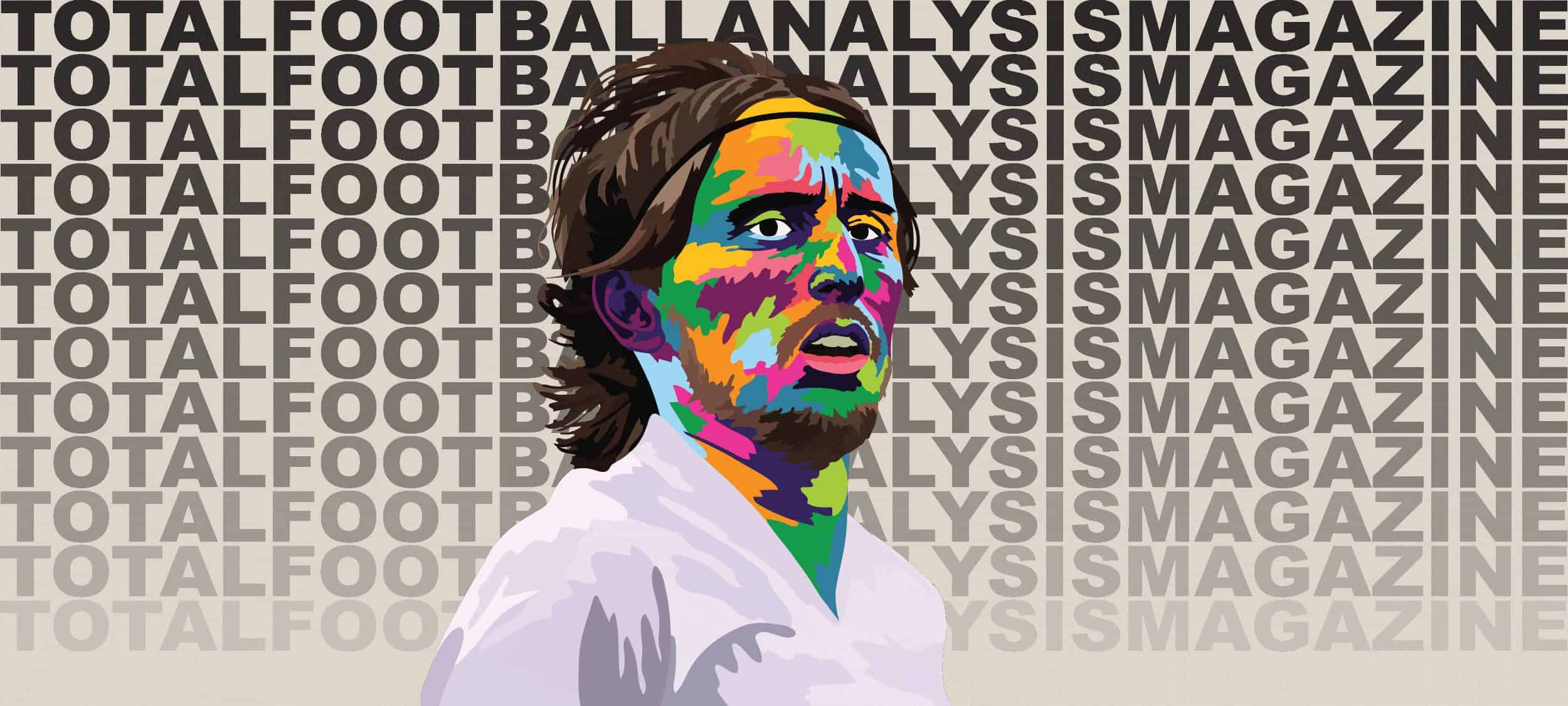




Comments